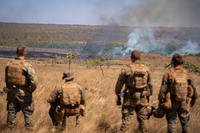FORT BRAGG, N.C. – Army Sgt. James Hayes has one piece of advice for soon-to-deploy mechanics: take your training seriously.
Hayes, a mechanic who deployed with the 82nd Airborne Division’s 1st Brigade Combat Team to Afghanistan in 2012, said that the first time he had to rely on his training to right a flipped armored vehicle, everything worked exactly as he had trained.
At stake was the life of a fellow paratrooper, Army Spc. Justin Lansford, a turret gunner who was pinned under the top of a mine-resistant, ambush-protected vehicle after it was flipped by an exploding improvised explosive device. Lansford was critically wounded and was bleeding heavily from femoral arteries.
“I remember thinking it was going to turn bad quick if I didn’t do it right,” said Hayes, a freckle-faced former German citizen and son of an American soldier.
When Hayes, Army Cpl. Joshua Dobson and two other mechanics arrived at the attack site, medics were treating Lansford, and the damaged vehicle was on fire, Hayes said.
After extinguishing the fire, the mechanics determined the correct lifting points and amount of winch force to apply based on the vehicle’s weight, and gently lifted the wreckage high enough to extricate the pinned paratrooper.
“I can’t even explain to you how rewarding that feeling was,” Hayes said.
Lansford was airlifted from the battlefield, eventually recovering from his injuries at Walter Reed National Military Medical Center in Bethesda, Md. Although Lansford lost both of his legs above the knee, he was glad to be alive, he said.
During Hayes’ six-month deployment, he and his team recovered 15 to 20 vehicles. Most were for mechanical failures or driver inexperience, or a combination of the two, he said.
On one convoy, three vehicles, including Hayes’ wrecker, were struck by IEDs within seconds of each other. He and Dobson escaped injury, but soldiers in both of the other two vehicles were medically evacuated by helicopter.
The wrecker had been towing a damaged vehicle when it was hit, so mechanics used a larger truck to tow both vehicles in-line, Hayes said. The train of towed vehicles may have looked odd, he said, but it worked to take them off the battlefield.
“The training really works,” Hayes said.

























